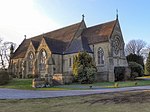Walkden Gardens
Parks and commons in TraffordSale, Greater Manchester

Walkden Gardens is a public green space in Sale, Greater Manchester, England. The gardens are named after Harry Walkden on whose death in 1949 his plant nursery passed to Sale Borough Council and provides the site for the gardens. The gardens are owned by Trafford Council and The Friends of Walkden Gardens help maintain and develop the gardens. A notable feature of the gardens is the dovecote moved there from the grounds of the now demolished Sale Old Hall.
Excerpt from the Wikipedia article Walkden Gardens (License: CC BY-SA 3.0, Authors, Images).Walkden Gardens
Pengolia Walk, Trafford Sale Moor
Geographical coordinates (GPS) Address Nearby Places Show on map
Geographical coordinates (GPS)
| Latitude | Longitude |
|---|---|
| N 53.4184 ° | E -2.3123 ° |
Address
Memories Garden
Pengolia Walk
M33 3EL Trafford, Sale Moor
England, United Kingdom
Open on Google Maps






